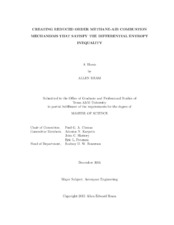| dc.contributor.advisor | Cizmas, Paul G | |
| dc.creator | Ream, Allen | |
| dc.date.accessioned | 2016-05-04T13:17:48Z | |
| dc.date.available | 2017-12-01T06:36:19Z | |
| dc.date.created | 2015-12 | |
| dc.date.issued | 2015-08-19 | |
| dc.date.submitted | December 2015 | |
| dc.identifier.uri | https://hdl.handle.net/1969.1/156362 | |
| dc.description.abstract | To simulate the combustion of a flame, or any reacting fluid flow, it is necessary to incorporate a reaction mechanism which describes the incremental steps and associated rates leading from reactant species to products. Detailed mechanisms include all possible species and elementary reactions so as to provide accurate solutions in a wide range of simulation conditions. Unfortunately, there is a large computational cost associated with the complexity of detailed mechanisms. Reduced mechanisms are created for specific conditions where simplifying assumptions can be made to decrease the complexity of detailed mechanisms. However, it has been shown that common reduced mechanisms produce violations of the differential entropy inequality (DEI), a local form of the second law of thermodynamics.
In this thesis, a new method is developed to determine rate parameters for reduced mechanisms which satisfy the DEI. Two mechanisms were created using this method. They are labeled the optimized two- and three-step mechanisms. In one-dimensional simulations, the optimized two- and three-step mechanisms predicted flame characteristics better than previous methods. The sharp transition from creation to destruction of minor species was better resolved and the error in flame speed prediction was reduced by up to 47.5%. A numerical model of the Sandia flame A was used as a test case to investigate violations of the DEI. Unphysical flammability limits in all reduced mechanisms allowed pre-ignition of the flame, causing errors when compared to experimental data. Both the optimized two- and three-step mechanisms produced no violations of the DEI. A two-dimensional flame simulation using the detailed GRI 3.0 mechanism was run for the first time and violations of the DEI were found. | en |
| dc.format.mimetype | application/pdf | |
| dc.language.iso | en | |
| dc.subject | combustion | en |
| dc.subject | reduced mechanism | en |
| dc.subject | differential entropy inequality | en |
| dc.title | Creating Reduced Order Methane-Air Combustion Mechanisms That Satisfy the Differential Entropy Inequality | en |
| dc.type | Thesis | en |
| thesis.degree.department | Aerospace Engineering | en |
| thesis.degree.discipline | Aerospace Engineering | en |
| thesis.degree.grantor | Texas A & M University | en |
| thesis.degree.name | Master of Science | en |
| thesis.degree.level | Masters | en |
| dc.contributor.committeeMember | Karpetis, Adonios N | |
| dc.contributor.committeeMember | Slattery, John C | |
| dc.contributor.committeeMember | Petersen, Eric L | |
| dc.type.material | text | en |
| dc.date.updated | 2016-05-04T13:17:48Z | |
| local.embargo.terms | 2017-12-01 | |
| local.etdauthor.orcid | 0000-0001-6173-2588 | |


